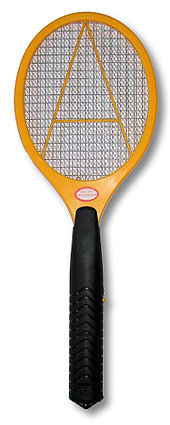Electric fly swatter
An electrical fly swatter is a tennis racket -like shaped device whose function on the action of an electrical voltage is based between different parts of its covering.
construction
Standard models can be divided into those with one and those with three grids. In models with three grids (made of parallel wires, spot-welded wires, expanded metal , ...) the two outer grids form one electrode, the inner one the other. Models with only one grid have only parallel wires that are alternately assigned to the two electrodes.
Circuit technology
A blocking oscillator generated by a high-voltage transformer , an AC voltage of several hundred volts. Using a high-voltage cascade , a high DC voltage (usually more than 1000 V) is generated to charge a capacitor . Its stored energy is released in one fell swoop when touched.
functionality
The device can be activated using a button on the handle. If the button is held down, a high voltage of approx. 1000 V is applied between the two electrodes . If parts of the body of mosquitoes , flies or other insects bridge the air gap between the electrodes, an electric current flows through them : The insects suffer an electric shock , usually accompanied by an electric spark (flash of light, bang ) , which often but not always for it is fatal. Electric fly swatters are usually operated with two Mignon cells ( batteries or equivalent rechargeable batteries ) and are rarely equipped with a connection to the mains for charging the batteries.
application
The user holds down the button on the handle and moves the high voltage grille around the room to touch insects. This often results in several bangs and lightning bolts in quick succession. According to the operating instructions of a device, hitting the surface of the bat with an activated electric fly swatter on human skin that is being touched by an insect (e.g. where a mosquito is sucking blood) is an intended application and harmless to humans, since humans are not come into contact with the inner grille, but the mosquito does. Hair is usually not electrically conductive and therefore does not pose a risk of injury; however, pushing a fingertip through the outer grille and reaching the inner grille will give you an electric shock. Devices without a protective grille are not suitable for this application.

